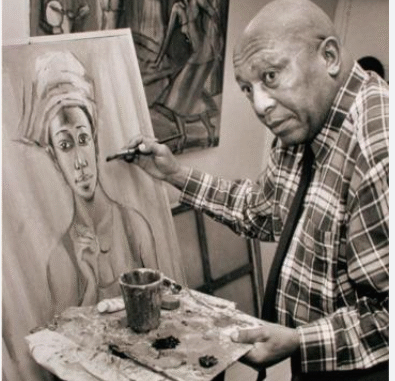
Gerhard Sekoto was a South African painter and musician. He is known for urban scenes, portraits, and social realism. His work captures everyday life, culture, and social issues in South Africa. Sekoto is considered a founding figure of modern South African art.
Early Life
Gerhard Sekoto was born in 1913 in Evaton, Gauteng, South Africa. He grew up in a community shaped by colonial and apartheid-era structures. Sekoto showed an early interest in music and painting. He studied at the Johannesburg Art School while developing his skills in observation and portraiture.
His upbringing in township life influenced his choice of urban and social themes.
Artistic Beginnings
Sekoto started painting in the 1930s. He worked as a piano teacher, musician, and artist to support himself. His art focused on township life, street scenes, and portraits of ordinary people. He became recognized for his vivid color palette, realism, and humanist approach.
Major Works
-
Street Scene, Johannesburg (1940s) – Depicts urban township life with detail and color.
-
The Musician (1939) – Portrait reflecting Sekoto’s interest in music and culture.
-
Woman in Blue (1945) – Humanist portrayal of ordinary life.
-
Self-Portrait (1939–1940) – Early work showing his developing style.
-
Exile Works (1950s–1980s) – Created after moving to France, addressing isolation and identity.
Street Scene, Johannesburg (1940s)
A signature work capturing township life and everyday interactions. Sekoto uses color, perspective, and human expression to convey social realities. It reflects both urban vibrancy and societal constraints.
The Musician (1939)
Portrays a musician at work, blending Sekoto’s love of music and art. It celebrates creativity and cultural expression under restrictive social conditions.
Exile Works (1950s–1980s)
Sekoto left South Africa in 1947 for political reasons. In France, he continued to paint township memories, portraits, and social commentary. His exile works show longing, identity, and human resilience.
What Makes Him Different
-
Pioneer of modern South African painting.
-
Combines realism, color, and social commentary.
-
Focuses on ordinary people, urban life, and township culture.
-
Exile experience deepened his exploration of identity and belonging.
-
Work is both aesthetic and socially conscious.
Sekoto’s art bridges history, culture, and personal experience.
Who Experiences His Work
-
Art enthusiasts and collectors of African modern art.
-
Students and scholars of South African art, social realism, and exile literature.
-
Museum-goers exploring urban life, culture, and history.
-
Global audiences interested in modernism and social commentary.
His work appeals to both academic and general audiences.
Collaborations and Influence
-
Exhibited internationally in galleries and museums across Europe and Africa.
-
Influenced generations of South African artists exploring modernism and social realism.
-
Inspired visual storytelling of township life and cultural identity.
Sekoto helped shape South African modern art and inspired future artists.
Activism and Cultural Role
Sekoto’s work subtly critiqued social and racial inequality. He highlighted ordinary lives under apartheid through art. His paintings give voice to township communities and cultural expression. Sekoto contributed to South African culture by documenting urban life and identity.
Later Years and Legacy
Gerhard Sekoto spent the latter part of his life in France, continuing to paint until his death in 1993.
His work is part of major collections, including the South African National Gallery and international museums. Sekoto is celebrated as a founding father of modern South African art.
Legacy highlights:
-
Pioneer of modernism and social realism in South Africa.
-
Chronicler of township life and cultural identity.
-
Influencer of generations of South African artists.
-
Bridge between art, society, and history.
Words
Gerhard Sekoto was more than a painter. He was a chronicler of urban life and cultural identity.
His work captures ordinary people, social realities, and human resilience. Sekoto’s art combines beauty, realism, and social consciousness.
For anyone exploring South African modern art, township life, or social realism, Gerhard Sekoto is essential study.
Leave a Reply